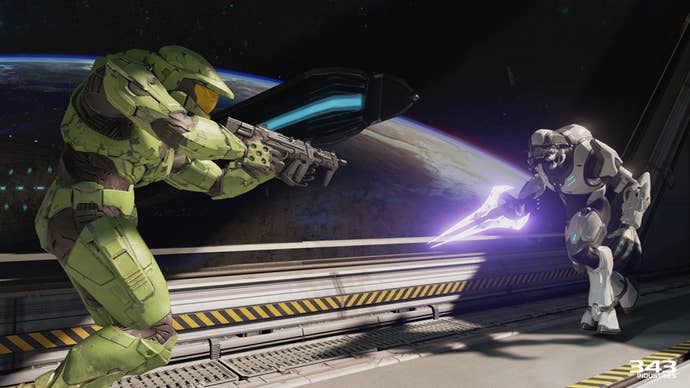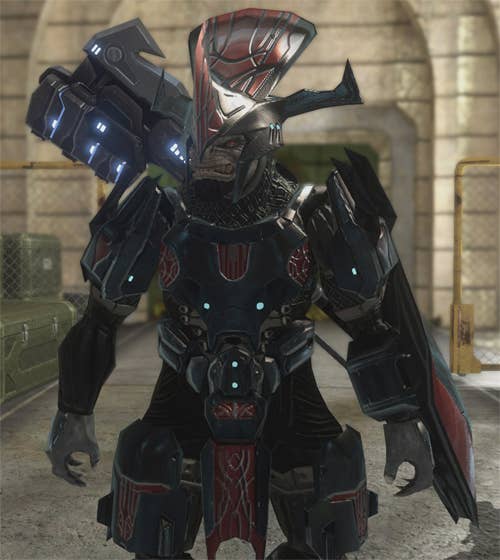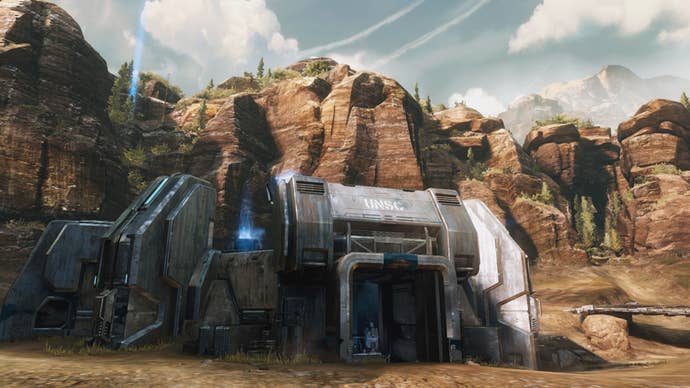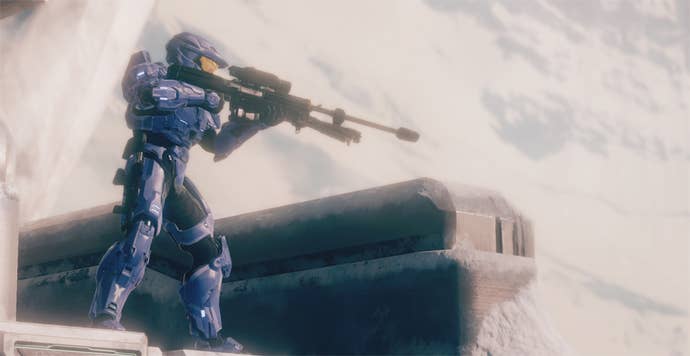Halo: The Master Chief Collection Xbox One Review: An Embarrassment of Riches
Jeremy and Kat weigh in on Microsoft's massive Halo anthology.
This article first appeared on USgamer, a partner publication of VG247. Some content, such as this article, has been migrated to VG247 for posterity after USgamer's closure - but it has not been edited or further vetted by the VG247 team.
Campaign Review: Jeremy Parish, Editor-in-Chief
I didn't expect to be interested in Halo: The Master Chief Collection. After being so badly disappointed by the antiseptic, alienating Halo 4, I had to look deep inside myself to find even an ember of enthusiasm for this new compilation.
It's a far cry from the interest that burned years ago, when the games collected here were new. I spent a week immersed in Halo 2, playing and replaying it to make sense of its story; the Halo 3 preview I wrote for Electronic Gaming Monthly remains the single magazine cover story of my time in the press, a career high point. Really, I signed up to review the collection simply because I thought, hey, I've played these games already, so I can talk about them from a place of experience. But I assumed it would be one of those assigments where I work my way through the content methodically, write my review, and move on to the next task at hand. What I didn't expect was to find myself addicted to the games anew. I didn't expect to be so touched.
Maybe "touched" is the wrong word — in no way am I moved by the narrative that binds these games. The series has its moments, no doubt. The original Halo's Flood reveal owes a tremendous debt to a dozen horror movies, not to mention Aliens, but that doesn't make it any less effective. And I still think the Arbiter's introduction as one of Halo 2's playable character is by far the best point-of-view fakeout in any game to date, even better than the Raiden reveal in Metal Gear Solid 2. It felt less like the developers were trying so earnestly to shock; Halo 2 felt more comfortable with itself than Metal Gear. But these are merely punctuation marks amidst a sci-fi tale of the pulpiest order, a non-stop march to heroism revolving around the tireless gunplay of a character who couldn't be any more of a blank if he lacked dialogue.
It's not the story that gets to me but rather the world design, the combat systems, the feel of the games. Sure, there's an element of nostalgia to it, for these games I've played so many times through the years, but even that only goes so far. It feels indescribably weird to go back from the built-of-Halo-DNA Destiny to its inspiration, where you're doing the same basic things so differently. After two weeks of playing Halo, I'm still having trouble rewiring my brain to remember that pulling the left trigger makes you chuck grenades rather than bring up your rifle's iron sights. Even after pouring many hours into these four games' campaigns, I still occasionally find myself trying to take aim with the now-industry-standard left trigger only to see poor Master Chief's corpse go flying across the screen a few seconds later from the blast of the frag I've stupidly tossed at my own feet.

Second sight
Halo: Master Chief Collection contains four games and an ocean of extras. By far, however, I've spent the most time with Halo 2.
That makes sense from a pragmatic perspective: Of the entire set, here, Halo 2 is the only truly new piece of content, a comprehensive reworking of the 10-year-old shooter with modern visuals and top-flight CG. The CG replaces the old in-engine cutscenes, which were impressive for their time but suffered from distracting texture-drawing issues that had a tendency to leave characters looking like slightly melted popsicles in the midst of what were meant to be dramatic moments. In fact, I'd guess the Master Chief Collection almost certainly got its start as a Halo 2: Anniversary Edition until someone realized that it would be awkward to have only one Halo title — and the most "incomplete" one at that — playable on Xbox One. And so, the other three core entries in the series were included along with it, each reworked by a different developer.
Like the Halo: Combat Evolved remake from a few years back (which is the version reproduced here), the Halo 2 anniversary edition runs two games at once. You can swap between the original Halo 2 and the remake with the press of a button, replacing slick contemporary graphics with the darker, blob-like polygons of the Xbox game. This slavish fidelity to the original does mean that the remake lacks any change to mechanics or even world geometry; the idea is for both games to run concurrently, like those savant gamers who play two different Mega Man games simultaneously with the same button presses. As a result, some of the weaker elements of the game remain weak; this is about prettying up the old, not improving on it.
Still, those improvements impress. Halo 2 pushed the original Xbox hardware to its ragged, gasping limits, but even running in full 1080p HD with all sorts of lighting effects and shaders that didn't even exist in 2004, its boxy world doesn't exert any particular strain on the Xbox One. The game runs silky-smooth, and it does so consistently — something that unfortunately isn't entirely true for Halo 3 or 4, which look great here but lack the sheer crispness of Halo 2 redux. That 10-year-old game plays better than ever before thanks to the tremendously increased resolution and framerate; I generally don't share gaming's collective obsession with 1080p/60fps, but when it comes to first-person shooters it makes a world of difference to precision and responsiveness. And Halo 2 — the new Halo 2 — is by far the most playable Halo game to date.

Evolution evolved
It's also, I'm remembering as I re-experience it, by far the most interesting campaign of the entire series. Despite Halo 2's reputation as a disappointment, for being rushed to completion after Bungie had to start over from scratch midway through development, its story hooked me. A big part of that has to do with the Arbiter, the alien holy warrior whose mission comprises half of the campaign.

Fans railed against the Arbiter. They were furious that they had to play a bad guy, that they had to step into the shoes of the side opposing their empty avatar of robotic heroism. Given the context of the times, it was difficult not to see the Arbiter's journey — ruthlessly skilled embodiment of a holy war prescribed by a cabal of priests who sought to foment an all-consuming war regardless of its actual righteousness — as a commentary on the war America had entered into during Halo 2's development. The first Halo made the Covenant into fearsome enemies, but it was all black-and-white; Halo 2 humanized them, giving the Elites the ability to speak in English instead of the incomprehensible cries they uttered in Halo. The Arbiter put a noble, even sympathetic face to the enemy. No wonder there was such blowback that Bungie could only make non-Master Chief characters playable in the sequels by adding cooperative play.
But the Arbiter's stages are by far the most interesting portions of Halo 2. It's not necessarily that his actual levels are better designed, mind you; it's just that the Arbiter himself undertakes a far more compelling journey than the Master Chief. The latter amounts to little more than a talking gun, by design; his entire gimmick is that he's a man made into a flawless weapon. The Arbiter, on the other hand, is a warrior cast down into utmost disgrace, turned into a symbol and sent by his masters to die for their questionable causes. The Master Chief fights tirelessly to preserve the human race (even if, as has increasingly become clear through Halo fiction and lore, the human race may not deserve saving), while the Arbiter fights instead to come to terms with the sham perpetuated by the Covenant's ruling cabal.
Halo 2 also stands at the midpoint between '90s FPS design and the more modern sensibility that defines the genre. Halo: CE was cut very much from the '90s mold, with huge, open spaces to fight through and a number of nonlinear levels. Ironically, the parts that people hated most about Halo — the linear Forerunner spaces where you're lead around by an AI companion, such as the Library — are the parts that most resemble the modern FPS. Meanwhile, Halo 3 and 4 are very much cut from the new mold, offering few opportunities to wander and let up on the relentless pace of the action. Halo 2's remake even incorporates some of Halo 4's Call of Duty aspirations, with a constant stream of pop-up icons denoting kills streaks and headshots, even in campaign mode.
Taken as a whole, the Master Chief Collection — perhaps inadvertently — paints a picture of the evolution of first-person shooters over a decade. Halo helped push the genre's direction, but it's also been equally subject to the influence of others as well. Halo 4 is a very different game from Halo: CE, despite the common foes, weapons, and underlying mechanics. Whether you enjoy the shape the series undertook or resent it, though, having the entire set here in a single compilation — especially when this could just as easily have been a standalone release for a Halo 2 remake — represents both a vast amount of content and an excellent value.

More than memories
I've been with the Halo series from before the start, from back in the '90s, when Bungie first began to dabble in the idea of viral campaigns aimed at their fan sites. I've watched the series mutate from a Mac-exclusive strategy action game in the Tribes vein to an Xbox-exclusive streamlined FPS. I've followed its story, enjoyed it spinoffs, and debated the merits of the changes both Bungie and 343 Industries have inflicted on it. I've assumed, by and large, that I'm over the series — but this compilation has made me realize that no, I'm not. And the little hints of Halo 5 bookending the Halo 2 remake have me curious to see where the series goes next.
The Master Chief Collection manages to bundle a lot of memories and experiences into a single package, all dusted off and given a new sheen of technology. The games here are presented the way I remember them, not necessarily the way they actually were. Halo 3 didn't run in true HD. And Halo 2 sure as hell didn't look like this.
There are a few details I don't really care for with this compilation. I appreciate the fact that the campaigns are presented to allow you to jump into any chapter at any time, but the unification of the single- and multiplayer presentation seems graceless when you try and play the games from start to finish, with big, disruptive tally cards at the end of each mission and loading times interrupting the transitions. Halo 2 is the only game that feels like it's been totally overhauled for Xbox One, and the technical inconsistencies in the other titles can be a bit irksome.
These are minor complaints, though. The sheer amount of content available here, and the effort that's been put into reworking them, goes above and beyond anything I expect from the increasingly rapacious games industry, where nickel-and-diming players into submission has become the order of the day. There's a lot of great old content on this disc, but perhaps the best blast from the past is that this anthology feels generous and complete — a real rarity. I have a feeling the Master Chief Collection will remain in my regular rotation for as long as I play Xbox One.
Multiplayer Review: Kat Bailey, Senior Editor
If I've learned anything over the past few years, it's that the team at 343 Studios are bigger Halo nuts than anyone. And for the most part, that fandom has served them well, as they have mixed it with out-of-the-box thinking that has produced features like Halo 4's much-lauded Spartan Ops.
Their latest project is the kind of all-encompassing franchise tribute that is rarely seen these days, even among old-school series like Super Mario Bros. and Mega Man. It's just the sort of collection I would expect to see out of a group like 343 Studios, even if The Master Chief Collection is ultimately a collaboration that also includes Certain Affinity, Ruffian Games, and Saber Interactive. The sheer scope of it all, as Jeremy describes above, makes it a genuine labor of love.

Like with the single-player campaigns, Halo: The Master Chief Collection's multiplayer is notable for both its completionism and for its willingness to go above and beyond expectations. In addition to including every map, mode, and extra from a decade's worth of Halo multiplayer, The Master Chief Collection includes six remastered maps from Halo 2, complete with extra perks like a killcam. And though the Halo 2 Anniverary Mode doesn't necessarily put the series back at the cutting edge of shooters, which was where it sat back in 2004, it's nevertheless notable just how good old favorites like Ascension and Lockout—now renamed Zenith and Lockdown respectively—look in the remastered version.
Even if you opt to stick with the classic variants, however, it's striking how well Halo's multiplayer has held up over the years. Get past the bland, somewhat chunky textures in the classic versions0, and you find a well-paced shooter with a very strong and balanced variety of weapons, ranging from the basic pistol and SMG to the more esoteric energy swords and power weapons. The mobility of the Spartans and the strategic application of grenades are other elements that help Halo stand out from the pack even today.
Admittedly, some parts of the experience hold up better than others. Halo: Combat Evolved, as much as many fans swear by it, is noticeably slower and quieter than shooters today, making it feel like something of a throwback, especially when playing on large, empty maps like Blood Gulch. Sniper rifles are also persistently overpowered in the first game, which I was reminded of when I was immediately shot dead from across the map after spawning. On the other end of the spectrum is Halo 4, which is more modern in some respects, but occasionally feels... off. Maybe it's the new weapons, which feel like off-brand Covenant tech in places, or maybe its the map design, but Halo 4 never seemed to resonate with fans in the same way as the other games. That feeling of being not quite right persists in Halo: The Master Chief Collection, which I suspect will make it somewhat less popular with the hardcore fans who are apt to populate its servers.

Speaking of which, Halo: The Master Chief Collection features dedicated servers, which is a boon for competitive players who want to eliminate lag as much as possible. On the other hand, I had a lot of trouble with games dropping and people getting booted just during the time I spent with an organized multiplayer session over the review, which perhaps doesn't bode well for the future. Definitely something to keep in mind for launch, especially as new players inevitably flood the servers following Black Friday and Christmas.
What'll be interesting to see if how well Halo: The Master Chief Collection ultimately balances novelty and nostalgia with the concerns of modernity, because this collection clearly has designs on being a major multiplayer platform, hence the inclusion of the Halo 2: Anniversary Collection. In a year or so, it's entirely possible that its servers will clear out as fans move on to Halo 5: Guardians, and more casual shooter enthusiasts return to Call of Duty or some other flavor of the month FPS. Put more simply, it's hard for me to say whether Master Chief Collection's multiplayer is merely a fun trip down memory lane or a legitimate competitor in the shooter space. My gut tells me that there's an audience for it—after all, the original Halo 2's servers lasted years after the launch of the Xbox 360, and they need a home—but that that the audience 343 Studios and Microsoft have in mind for the multiplayer will be smaller than they expect. As well as it holds up, after all, Halo: Combat Evolved still feels very much like it was made back in 2001, which is evident even in the somewhat foreign layout that persists through the entire series, among other things mapping the zoom to R3 on the analog stick.
Ultimately, however, 343 Studios and company have done about as good a job as they possibly could in putting this package together, even going so far as to dig up maps from the PC version of Halo: CE for inclusion in the multiplayer. In every way that matters, The Master Chief Collection exceeds expectations, and that can be said for both the single-player and the multiplayer. Assumging multiplayer connectivity issues don't creep up, it's a worthy tribute to the series that served to define multiplayer shooters in the early 2000s. Even after having cut the cord and moved onto bigger and better things, I'm guessing that Bungie is relieved to know that their baby continues to be in the capable hands of their biggest fans.
VisualsHalo 2: Anniversary's multiplayer is gorgeous, matching much of what has been revealed of Halo 5: Guardians. Environments are particularly striking.
SoundWhen Halo wants to strike an epic tone it has some of the best music around. The rest of the time, it is subdued and mournful, but very effective.
InterfaceMaster Chief Collection has an overwhelming amount of content, but the interface manages to get the job done without being too confusing. Getting into a multiplayer match is painless despite the wide variety of available games and modes.
Lasting AppealWith four games worth of campaigns and multiplayer maps, plus remastered content, Master Chief Collection has a staggering amount of content. Its lasting appeal may depend on how much of a Halo superfan you are, though.
ConclusionHalo: The Master Chief Collection clearly sets out to be one of the videogame tributes ever assembled; and in doing so, its hard not to be impressed by the scope and ambition of its efforts. This is the definitive collection of Halo: Combat Evolved through Halo 4, effectively presenting both classic and remixed content in a way that makes it feel like more than a simple trip down memory lane. Assuming it avoids issues with multiplayer stability, it's possible that it will end up being relevant as a shooter for a long time to come.

